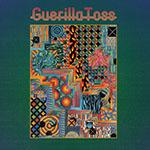
Guerilla Toss Twisted Crystal
(DFA Records)
Feel free to balk at the term “catchy,” but that’s an attribute you can easily apply to Meteorological. As the lead single to Guerilla Toss’ new album, Twisted Crystal, Meteorological is beat-driven, synthesized sugar, a pattern of electro-pulses and minimalist bass groove broken up by howling guitar accents. Vocalist Kassie Carlson rattles off her verses like a resigned cheerleader, her somewhat comical syllabic emphasis channeling both ditz and spirit:
“Hands up. I give up. Sitting. Sitting. Waiting. Hoping. Staring. Sleeping. Am I thinking? Wondering why.”
Is this sardonic pop? Perhaps, but this is where Guerilla Toss seems content to find space for themselves, taking cues from the annals of post-punk’s most seminal period when funk, dance, rock, dub, and even hip-hop could co-exist and inspire other genres, developing a more dance-friendly brand of eccentric disco and avant electronics.
In terms of notes and sounds, Twisted Crystal is densely populated, a continuation of the peculiar circuitry and acid-bathed vision the band explored for 2017’s excellent GT Ultra. As droid’ist embellishments dance through the ether of the album’s opening track, Magic Is Easy, Carlson is gently melodic (“The tip of the iceberg… The edge of the ice cube...”) as a cartoonishly wah-wah’d bass riff springs beneath a symphonic guitar solo, generating one of the oddest musical combos I’ve heard. As I’ve listened to the song more and more, it’s as if through experimentation that Guerilla Toss found a way to incorporate the neoclassical within the context of post-punk or art rock without pretense. Or, they’ve traced some element of their aesthetic back to Bill Laswell, whose involvement in Public Image Ltd’s 1986 release, Album, led to collaborations with Bernie Worrell, Tony Williams, Ginger Baker, and Steve Vai, pairing virtuosity with a figure like John Lydon, whose musical lineage with PiL had up to that point been based in raw, unfiltered minimalism. Somehow, it worked then, and it works well here.
It’s a “rock” moment in an “art” album and it’s a refreshing thing to hear. It’s not as if guitarist Arian Shafiee is really out front. Honestly, the group conjures so much electronic melody, tone and oddball elements that Shaifee just fits very nicely into his surroundings. The first few times I listened to Magic Is Easy, it didn’t even register that I was hearing a very refined guitar solo in the context of an otherwise artful song structure.
As far as Guerilla Toss’ pop sensibilities, and exactly how much the band manages to fuck around with the formula, they don’t shy away from either applying religious subject matter to nursery school rhyme schemes (Jesus Rabbit) or pulling modern trap motifs into a Numan-esque beat track (Retreat). The bouncy jog of Come Up With Me is carried by pleasant synthesizer tones and a nice ascending guitar riff; meanwhile, the rather epic tom-laden stroll and heavy vocal harmonies that drive Wall of the Universe provide Twisted Crystal its grandest and most graceful gesture. For Jackie’s Daughter, a minimal bass riff bows to Tina Weymouth as dance loops anchor a multitude of sounds from space ship consoles and otherworldly imaginings. The amusingly bizarre Hacking Machine is no less accessible, though evocative of the band’s more jagged material from 2016’s Eraser Stargazer.
Closing the album is Green Apple, with some harsh guitar scrapings playing dissonant-like, sort of akin to the corrosive sounds John Cale would scratch from his violin during his days in The Velvet Undergound, as an anxious, melting synth tone plays against an urgent percussive loop. Carlson narrates her verses, short bursts of exposition that are fragmented and abstract. “Listen to the drywall,” she instructs. “The rubbing on your shoes.” Shafiee adds a winding guitar melody for the hook, one last rock moment before the album ends.
The intense amalgamation of influences and sounds that Guerilla Toss employ and reconfigure in Twisted Crystal are adroitly drawn from a period of time that seems almost mythic at this point. When you consider that rock music has been more or less banished to the underground, think of the late 70s and the early 80s when a figure like Seymour Stein could see fit to start up a label like Sire off the back of Warner Bros. so that he could release music by Ramones and The Talking Heads. Think of Brian Eno, who was not only wowed by the then-new sonic ground being explored by groups like Kraftwerk and, most especially, Cluster, but that he brought this music to David Bowie, who then gave it to Iggy Pop. To build onto Eno, think of the fact that he documented late 70s No Wave with the No New York compilation and that he partnered with David Byrne to create My Life in the Bush of Ghosts. Think of the fact that a personality like Laurie Anderson (not to mention Nina Hagen) could not only have major label records, but work with artists like Peter Gabriel, Nile Rodgers, Adrian Belew and the aforementioned Laswell. Think of where post-punk took rock n’ roll and how it offered room to grow for categorically non-rock acts like Art of Noise and Cabaret Voltaire. And, finally, think of how The Velvet Undergound made most of this possible a full decade, or more, earlier.
Twisted Crystal is not pastiche, but it’s a stylistic reminder that music can be exciting, that pop music can be thoughtful and creatively liberating, and that being “catchy” isn’t necessarily a bad thing. For them, this magic is easy.
24 September, 2018 - 06:30 — Sean Caldwell